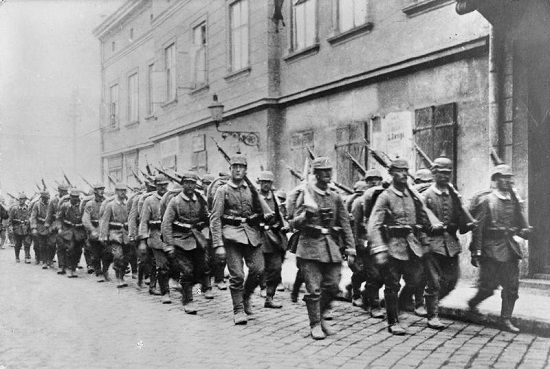Before the start of the Great War, British officers attended a German exercise which demonstrated their massed close formation infantry attacks. The British observers were appalled at the thought of what would happen to them against a trained modern army. On August the 23rd 1914 they were proved right.
The Germans launched a massive attack on the British lines at Mons. However they immediately ran into massed rifle fire from the British. The volume of fire laid down by the British line convinced the Germans the British had at least 28 machine guns per battalion. In reality the British only had two. To give an idea of the damage inflicted here are the words of a British soldier:
"Our rapid fire was appalling, even to us. The worst marksman could not miss. As we had only to fire into the brown, of the masses of the unfortunate enemy. Who on the fronts of our two companies were continually and uselessly reinforced at the short range of 300 yards."
The 4th Royal Fusiliers were defending a solid metal railway bridge, called Nimy. They had their machine gun section, commanded by Lieutenant Maurice Dease, deployed on the bridge. The rifle companies were deployed on the canal bank. Both guns were in sandbag positions so cramped that there was barely enough room for the crews.
The first contact with the Germans was when a five man cavalry patrol was challenged by a sentry. The Germans turned to flee, but all five were hit by the sentries fire, the four soldiers were killed by the rapid firing sentry, and the officer wounded, and taken prisoner.
When the Germans attacked at about 11am, they suffered terrible casualties, both from the riflemen and from the machine gun section. However the Germans had other tricks of their own. Another new weapon was the aeroplane. The Germans used these to guide their artillery onto the British line and began to pound them, while mounting larger and more vicious ground attacks.
 |
| Lieutenant Maurice Dease |
While manning the gun Lt Dease was hit for a fourth time, but still he continued to fire. Finally a 5th wound rendered him unable to man the machine gun. Lt Dease was evacuated to the rear, but died from blood loss shortly afterwards.
 |
| Nimy Bridge is in the background |
 |
| Private Sidney Godley |
Despite this Pvt Godley manned the Vickers gun and it began its work again.
By now the casualties and pressure from the Germans was so great the 4th Royal Fusiliers had to withdraw. About 1400 they began to pull back. Pvt Godley stayed in position firing away despite getting hit twice himself. One wound was a German bullet hitting him in the head and becoming lodged in his skull. Meanwhile his regiment continued to pull back. Eventually about 1500 the withdrawal was complete. However Pvt Godley was still in position, alone, firing at the Germans and holding up several divisions. Eventually Pvt Godley's machine gun ran out of ammunition. Pvt Godley unlocked the gun from its tripod, picked up the hot weapon and smashed it several times against a bridge stanchion and then he heaved the gun into the canal, all to prevent its capture by the Germans.
He then retired after his comrades. However once on the other side of the bridge he was captured by the Germans, whom gave him medical treatment. Pvt Godley then spent the rest of the war as a POW.
Both Lt Dease and Pvt Godley won Victoria Crosses. It should be remembered that there were other medal winners on that day, such as another VC and on the German side a Private Niemeyer who leapt into the Mons canal and swam across it in the face of British gunfire to activate a swing bridge, allowing the Germans to pour across. And so started the retreat from Mons. One thing to remember about the First World War, is that contrary to popular ideas it had fairly large sweeping battles of movement, and it was only the stalemate in middle part of the war that had the trench warfare.


No comments:
Post a Comment